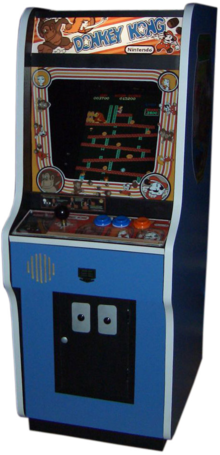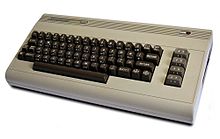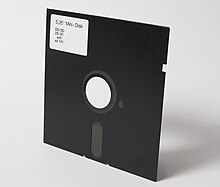History of the Video Games 1980–1989
The following is the most important data on computer and video game history from 1980 to 1989 .
Platforms
Arcade games
Arcade games were often significantly more powerful than other platforms, especially graphically. Some games originated as arcade games and appeared a little later as implementation on consoles and home computers. The golden era of arcade games lasted until the mid-1980s. From 1984, 16-bit processors were sometimes used in the construction of slot machines.
Consoles
In the 1980s, many game consoles appeared , mostly with an 8-bit architecture. The Nintendo Entertainment System , which appeared in Germany in 1986, and the Sega Master System , which was offered in Germany from 1987 , were particularly widespread . Both consoles each brought their own series and characters. The earliest devices with 16-bit technology ( 4th generation ) appeared from 1987, in Germany not until 1990. At the beginning of the 1980s, the older consoles, especially the Atari 2600 , were still widespread
- 2nd generation
- ColecoVision (1982)
- Atari 5200 (1982)
- 3rd generation
- Nintendo Famicom (1983 Japan) / Nintendo Entertainment System (1986 Germany)
- Sega Master System (1987)
- 4th generation (8-bit processor, partially 16-bit properties)
- PC Engine / TurboGrafx 16 (1987)
- Sega Mega Drive (1988) 16 bit
- Nintendo Super Nintendo Entertainment System / SNES (1989)
Handheld consoles
- Nintendo Game & Watch (1980), LCD game
- Atari Lynx (1989), 8 bit
- Nintendo Game Boy (1989, in Germany 1990) 8 bit
Home computers
- Commodore VC 20 (1980)
- Tandy TRS-80 Color Computer "CoCo" (1981)
- Texas Instruments TI-99 / 4A (1981)
- Sinclair ZX81 (1981), simple model, monochrome display, membrane keyboard
- Sinclair ZX Spectrum (1982)
- Commodore 64 / C64 (1982), most successful home computer
- Atari XL (1982)
- Apple IIe (1983)
- MSX (1983), hardly widespread in German-speaking countries
- Amstrad CPC / Schneider CPC (1984)
- Atari ST (1985), 16-bit
- Commodore 128 (1985), less successful, games mostly in C64 mode
- Commodore Amiga (1985), 16/32-bit, very successful

Pc
- IBM PC (1981)
- IBM PC / XT (1983)
- IBM PC Jr. (1983)
- IBM PC / AT (1984)
In the 1980s, PCs were mainly used to play games on the MS-DOS operating system . Windows games only became established in version 3 from 1990 onwards.

Popular genres of the time
Almost all genres still known today existed in the 1980s. Simple game principles such as shoot 'em ups , action games , sports and racing games, adventure games and more extensive simulations were still particularly widespread . A new addition was the Jump 'n' runs and beat 'em ups . Many of the classics of that time are still popular as retro games today .
Online games
Simple text-based games such as mailbox (BBS) playable games and multi-user dungeons (MUDs) were early exponents of online games . From the middle of the decade, the first action and strategy games with a modem option for online games for two came onto the market.
Important developers
- Scott Adams (Adventure Games)
- Ken Williams
- David Braben , Game Elite
- Rob Fulop (Atari)
- Will Wright , game SimCity
Many games have been published by major publishers; the individual developers faded into the background. Extensive games were often created in larger teams.
Important companies
Nintendo and Sega dominated the game consoles together ; in home computers, Commodore was a leader with the C64 and Amiga models. PC games ( DOS games) only slowly gained acceptance, on the one hand due to the high acquisition costs and the initially limited hardware properties. The 16-color EGA standard did not exist until 1984 ; sound cards were mostly retrofitted later.
There were numerous companies in the arcade sector, including Atari / Atari Games , Konami , Taito , Sega, Nintendo, as well as Namco , Data East and Capcom .
Software companies emerged and disappeared in great numbers or were taken over. 1983 saw the collapse of the market in the USA, the video game crash . Well-known publishers were, besides the ones mentioned, for example Acclaim Entertainment , Accolade , Activision , Bug-Byte , Epyx , Sierra On-Line and Ubisoft .
Data carrier / costs
At that time, arcade games in Germany usually cost one DM per game and player, but the operators were able to set the level of difficulty and the number of "lives". Outside Germany, the costs were often lower.
Cartridges and compact cassettes were initially the usual data carriers for home computers . In 1982/1983 commercial games for home computers cost up to 89 DM, for consoles between 70 and 140 DM. Alternatively, games were programmed by oneself or program printouts were typed out from books or magazines. When the distribution of the devices increased sharply in the mid-80s and the first 5.25 " floppy disk drives appeared, the prices for games fell to around 50–60 DM and were usually much more demanding. The prices for empty media fell drastically and there were many Towards the end of the decade, 3.5-inch floppy disks were common (for Amiga and partly for PC) and a game usually cost up to 89 DM (Amiga) and 119 DM (PC), and the game was often there Distributed on several floppy disks, sometimes over 10. Despite compression, console games were much cheaper and often had fixed prices.
Chronicle / most important games of the decade
- Pac-Man (1980)
- Defender (1980), first game with scrolling
- Battlezone (1980), first first person view game
- Centipede (1980)
- Donkey Kong (1981), first jump 'n' run
- Frogger (1981)
- Q * bert (1982)
- Pole Position (1982), successful and first modern racing game
- Track & Field (1983)
- Tetris (1985)
- Double Dragon (1987)
- SimCity (1989)
Other popular games, some only on individual platforms, were:
- Ultima (1980), RPG on Apple II
- Microsoft Flight Simulator (1982), flight simulator on PC
- Elite (1984), simulation game on BBC Micro
- Super Mario Bros. (1985), Jump 'n' Run on Famicom / NES
- The Legend of Zelda (1986), action-adventure on NES
- The Great Giana Sisters (1987), Jump 'n' Run on C64 a. a.
- Defender of the Crown (1987), strategy game on Amiga a. a.
- Ports of Call (1987), trading simulation on Amiga
Other innovative, partly less well-known titles were:
- Mystery House (1980), first text adventure with graphics
- Space Panic (1980), first platform game, precursor to platformer
- 3D Monster Maze (1981), first 3D game for home computers
- Moon Patrol (1982), first game with parallax scrolling
- Dragon's Lair (1983), first popular laser disc game
- Ant Attack (1983), first 3D game with freedom of movement
- I, Robot (1983), first commercial game with 3D polygons
- Karate Champ (1984), first side view fighting game
- Little Computer People (1985), first life simulation
- Out Run (1986), first game with Force Feedback (force feedback)
Despite copy protection , black copies were widespread in the 1980s .
Indexing
Computer games were a new phenomenon in the 1980s; The Federal Inspectorate for Media Harmful to Young People (at that time still the Federal Inspectorate for Writings Harmful to Young People, BPJS for short) reacted quite helplessly and arbitrarily when it came to indexing games: Not only were games quite brutal - even by today's standards - like Commando Libya or Beach Head and Beach Head II (with realistic screams of dying soldiers), but also - by then and now - harmless games like River Raid and Blue Max , in which stylized planes and tanks were shot at. This led to the German version of the game Commando being slightly redesigned graphically - instead of soldiers in the version called Space Invasion, aliens were the opponents, which did not prevent the BPJS from indexing them as well.
This indexing policy led to a lack of understanding and a general rejection of the BPJS, especially since there were a lot of black copies in circulation at the time, so that the measures were ineffective; some indexed games (see section Propaganda) were also not freely available. Later the BPJS showed more sense of proportion when indexing.
Strangely enough, the BPJS also put clearly cracked games, i.e. black copies, on the table for evaluation. These media are likely to have been forwarded to the office from the households of concerned parents via the youth welfare offices, in accordance with the procedure. The further procedure corresponded to the rules, according to which suspicious media and unknown authors are always indexed first in order to provide further clarification. It should be obvious that this clarity could not be achieved with cracks. The 1942 trainer game (a cracked version of the 1942 game that has been expanded by a cheat ) is still on the index of works that are not freely available. Accordingly, Capcom or Elite is not specified as the publisher as the manufacturer for the medium , but an unknown person named Doctor Bit , under whose pseudonym the cheat was published and circulated. There are no signs of open commercial distribution, otherwise the original manufacturer would have taken appropriate measures.
See also
- computer game
- Retro game
- History of video games
- Game console # History of stationary game consoles
- List of game consoles
- Arcade game / arcade machine
- Category: Computer game by year
literature
- van Burnham, Supercade. A Visual History of the Videogame Age 1971-1984, ISBN 9780262024921 .
- Winnie Forster : Game consoles and home computers 1972-2005 . Gameplan, 2005, ISBN 3-00-015290-3 .
Web links
- 8bit Museum: Home Video Games
- The history of video games: 1978 - 1988 on Cynamite.de
- The best video games - the most important manufacturers on homecomputermuseum.de
Further web links and sources exist for general and special articles.






